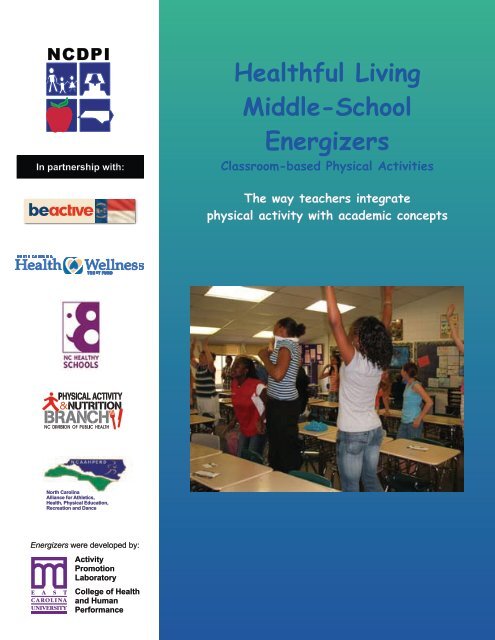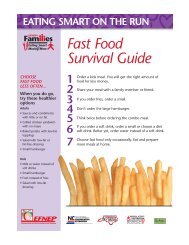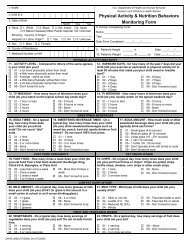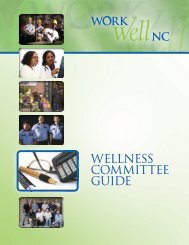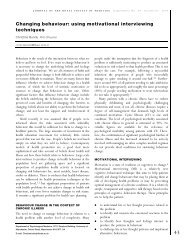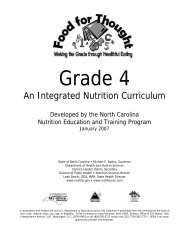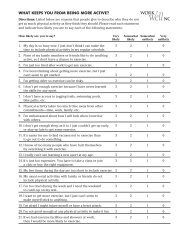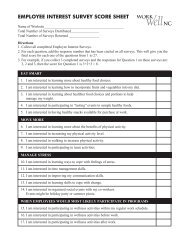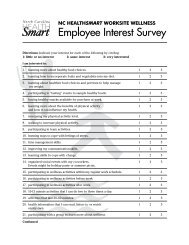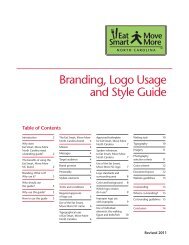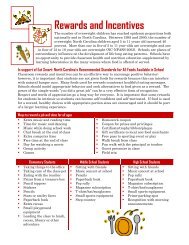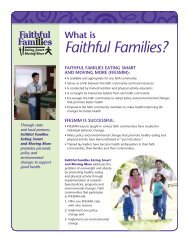Healthful Living Middle-School Energizers - Public Schools of North ...
Healthful Living Middle-School Energizers - Public Schools of North ...
Healthful Living Middle-School Energizers - Public Schools of North ...
- No tags were found...
You also want an ePaper? Increase the reach of your titles
YUMPU automatically turns print PDFs into web optimized ePapers that Google loves.
NCDPIIn partnership with:<strong>Healthful</strong> <strong>Living</strong><strong>Middle</strong>-<strong>School</strong><strong>Energizers</strong>Classroom-based Physical ActivitiesThe way teachers integratephysical activity with academic concepts<strong>North</strong> CarolinaAlliance for Athletics,Health, Physical Education,Recreation and Dance<strong>Energizers</strong> were developed by:ActivityPromotionLaboratoryCollege <strong>of</strong> Healthand HumanPerformance
<strong>Middle</strong> <strong>School</strong> <strong>Energizers</strong>AcknowledgementsThe “<strong>Energizers</strong>” weredeveloped by theEAST CAROLINA UNIVERSITYActivity Promotion LaboratoryDepartment <strong>of</strong> Exercise and Sport ScienceCollege <strong>of</strong> Health and Human PerformanceEnergizer Team Members:Matthew T. Mahar, Ed.D.Donna P. Scales, M.A.Ed.Tiana Y. Miller, B.A.Rhonda K. Kenny, M.A.Ed.A. Tamlyn Shields, M.A.The goal <strong>of</strong> the Activity Promotion Laboratory is to promote activelifestyles. We are indebted to the <strong>North</strong> Carolina Department <strong>of</strong> <strong>Public</strong>Instruction (NCDPI), Be Active <strong>North</strong> Carolina, Inc., NC Healthy <strong>School</strong>s,the NC Alliance for Athletics, Health, Physical Education, Recreation,and Dance (NCAAHPERD), and the Physical Activity and Nutrition Branchfor providing funding for this project. In particular, we wish to thankKymm Ballard at NCDPI for her non-stop support <strong>of</strong> the efforts to helpteachers integrate physical activity into the school day.In compliance with federal law, including the provisions <strong>of</strong> Title IX <strong>of</strong> the Education Amendments<strong>of</strong> 1972, N C <strong>Public</strong> <strong>School</strong>s administers all state-operated educational programs, employmentactivities and admissions without discrimination because <strong>of</strong> race, religion, national or ethnicorigin, color, age, military service, disability, or gender, except where exemption is appropriateand allowed by law.Inquiries or complaints should be directed to:Dr. Elsie C. Leak, Associate SuperintendentOffice <strong>of</strong> Curriculum and <strong>School</strong> Reform Services6307 Mail Service Center, Raleigh, NC 27699-6307Telephone (919) 807-3761; fax (919) 807-3767About the Cover: We would like to acknowledge and thank C.W. Stanford <strong>Middle</strong> <strong>School</strong> inHillsborough, NC for their work with the <strong>Energizers</strong> and allowing us to use the picture on thecover.Copyright © <strong>North</strong> Carolina Department <strong>of</strong> <strong>Public</strong> InstructionFirst Edition: July 2006The <strong>Middle</strong> <strong>School</strong> <strong>Energizers</strong> were developed by East Carolina University, Activity Promotion Laboratory inpartnership with the NC Department <strong>of</strong> <strong>Public</strong> Instruction (<strong>Healthful</strong> <strong>Living</strong> and Healthy <strong>School</strong>s Sections),the Health and Wellness Trust Fund, Be Active <strong>North</strong> Carolina, the NC Alliance for Athletics, Health, PhysicalEducation, Recreation and Dance, and the Physical Activity & Nutrition Branch.
<strong>Middle</strong> <strong>School</strong> <strong>Energizers</strong>NC Health and Wellness Trust Fund CommissionEstablished in May 2001, the NC Health and WellnessTrust Fund Commission (HWTF) invests in programs andestablishes partnerships to address the health needs <strong>of</strong>vulnerable and underserved populations in <strong>North</strong> Carolina.Recommendations from HWTF’s Study Committee onChildhood Obesity led to the amendment <strong>of</strong> the HealthyActive Children Policy requiring 30 minutes <strong>of</strong> dailyphysical activity for each child in grades K-8.Fit KidsFit Kids, an initiative <strong>of</strong> HWTF, will provide curriculumsupportmaterials to assist teachers with implementation<strong>of</strong> this mandate through a resource rich web site,www.FitKidsNC.com. HWTF will also provide trainings onphysical activity integration into the school day using theseweb site resources to all K-8 teachers in the state. Thesetrainings will be conducted through a grant to Be Active<strong>North</strong> Carolina and the Department <strong>of</strong> <strong>Public</strong> Instruction.The <strong>Middle</strong> <strong>School</strong> <strong>Energizers</strong> were developed by East Carolina University, Activity Promotion Laboratory inpartnership with the NC Department <strong>of</strong> <strong>Public</strong> Instruction (<strong>Healthful</strong> <strong>Living</strong> and Healthy <strong>School</strong>s Sections),the Health and Wellness Trust Fund, Be Active <strong>North</strong> Carolina, the NC Alliance for Athletics, Health, PhysicalEducation, Recreation and Dance, and the Physical Activity & Nutrition Branch.
<strong>Middle</strong> <strong>School</strong> <strong>Energizers</strong>Energizer PartnersBe Active <strong>North</strong> CarolinaBe Active <strong>North</strong> Carolina, Inc. is a 501 (c)(3) non-pr<strong>of</strong>it organization dedicatedto improving the health <strong>of</strong> all <strong>North</strong> Carolinians. Our mission is to increase thephysical activity levels and healthy lifestyles <strong>of</strong> all <strong>North</strong> Carolinians throughpeople, programs and policies.The NC Department <strong>of</strong> <strong>Public</strong> InstructionThe <strong>North</strong> Carolina Department <strong>of</strong> <strong>Public</strong> Instruction is the agency charged withimplementing the State’s public school laws and the State Board <strong>of</strong> Education’spolicies and procedures governing pre-kindergarten through 12th grade publiceducation. The elected State Superintendent <strong>of</strong> <strong>Public</strong> Instruction heads theDepartment and functions under the policy direction <strong>of</strong> the State Board <strong>of</strong>Education.The agency has approximately 530 positions providing leadership and service tolocal public school districts and schools in the areas <strong>of</strong> curriculum and instruction,accountability, finance, teacher and administrator preparation and licensing,pr<strong>of</strong>essional development, and school business support and operations.The <strong>Healthful</strong> <strong>Living</strong> Section is responsible primarily for curriculum and staffdevelopment in the areas <strong>of</strong> health and physical education. In addition, we overseethe athletics, sports medicine, and drivers education programs for the K-12 publicschools.<strong>North</strong> Carolina Healthy <strong>School</strong>sThe <strong>North</strong> Carolina Healthy <strong>School</strong>s is funded by the Centers for Disease Controland Prevention. It is designed to create a working infrastructure betweeneducation and health to enable schools and communities to create a Coordinated<strong>School</strong> Health Program. The Department <strong>of</strong> <strong>Public</strong> Instruction and the Department<strong>of</strong> <strong>Public</strong> Health house the Senior Advisors who establish relationships and buildcapacity. A model school health program includes these eight components:• Comprehensive <strong>School</strong> Health Education• <strong>School</strong> Health Services• A Safe Physical Environment• <strong>School</strong> Counseling, Psychological and Social Services• Physical Education• Nutrition Services• <strong>School</strong>-Site Health Promotion for Staff• Family and Community Involvement in <strong>School</strong>sNC Healthy <strong>School</strong>s focuses on improving the health <strong>of</strong> students and staff byproviding coordination and resources. With all <strong>of</strong> these components in place andworking together, students will be healthier in school, in class, and ready to learn.Continued on next pageThe <strong>Middle</strong> <strong>School</strong> <strong>Energizers</strong> were developed by East Carolina University, Activity Promotion Laboratory inpartnership with the NC Department <strong>of</strong> <strong>Public</strong> Instruction (<strong>Healthful</strong> <strong>Living</strong> and Healthy <strong>School</strong>s Sections),the Health and Wellness Trust Fund, Be Active <strong>North</strong> Carolina, the NC Alliance for Athletics, Health, PhysicalEducation, Recreation and Dance, and the Physical Activity & Nutrition Branch.
<strong>Middle</strong> <strong>School</strong> <strong>Energizers</strong> 5<strong>North</strong> Carolina Physical Activity and Nutrition (PAN) BranchThe Physical Activity and Nutrition Branch is housed within the NC Division <strong>of</strong><strong>Public</strong> Health, NC Department <strong>of</strong> Health and Human Services. The PAN Branchis the lead state agency for developing and implementing healthy eating andphysical activity interventions with state and local health agencies, as well as withcommunity partners throughout the state.The PAN Branch’s mission is to stem the rising tide <strong>of</strong> obesity and chronicdisease among <strong>North</strong> Carolinians by helping them to eat smart, move more andachieve a healthy weight. This mission is accomplished through the administration<strong>of</strong> successful statewide programs such as the NC Statewide Health PromotionProgram and the NC Arthritis Program.The PAN Branch staffs the Eat Smart, Move More…<strong>North</strong> Carolina movement,guided by the Eat Smart, Move More Leadership Team. The movement encourageshealthy eating and physical activity wherever people live, learn, earn, play andpray. Eat Smart, Move More…NC exists because statewide partners collaborateto increase opportunities for healthy eating and physical activity through changesin policies, practices and environments. The shared vision among the many partnerorganizations is a <strong>North</strong> Carolina where healthy eating and active living are thenorm, rather than the exception.For more information on Eat Smart, Move More...NC visitwww.EatSmartMoveMoreNC.comThe <strong>North</strong> Carolina Alliance for Athletics, Health, Physical Education,Recreation and Dance (NCAAHPERD) is an alliance <strong>of</strong> six associations:• Dance Education Association <strong>of</strong> <strong>North</strong> Carolina (DANCE)• <strong>North</strong> Carolina Association for Athletic Education (NCAAE)• <strong>North</strong> Carolina Association for the Advancement <strong>of</strong> Health Education(NCAAHE)• <strong>North</strong> Carolina Sports Management Association (NCSMA)• Physical Education Association (PEA)• Student Majors Association (SMA)NCAAHPERD’s mission is to provide advocacy, pr<strong>of</strong>essional development, and unityfor health, physical education, recreation, dance, and athletics pr<strong>of</strong>essionals andstudents in order to enhance and promote the health <strong>of</strong> <strong>North</strong> Carolinians. Ourvision is to be the leading organization promoting and supporting a healthier, morecreative, and active <strong>North</strong> Carolina.NCAAHPERD is one <strong>of</strong> <strong>North</strong> Carolina’s oldest pr<strong>of</strong>essional associations dedicatedto the advancement <strong>of</strong> research and education within the fields <strong>of</strong> Athletics,Health, Physical Education, Recreation and Dance. NCAAHPERD is involved inadvocacy initiatives locally and nationally.The <strong>Middle</strong> <strong>School</strong> <strong>Energizers</strong> were developed by East Carolina University, Activity Promotion Laboratory inpartnership with the NC Department <strong>of</strong> <strong>Public</strong> Instruction (<strong>Healthful</strong> <strong>Living</strong> and Healthy <strong>School</strong>s Sections),the Health and Wellness Trust Fund, Be Active <strong>North</strong> Carolina, the NC Alliance for Athletics, Health, PhysicalEducation, Recreation and Dance, and the Physical Activity & Nutrition Branch.
<strong>Middle</strong> <strong>School</strong> <strong>Energizers</strong><strong>Energizers</strong> BackgroundIn January <strong>of</strong> 2003, the State Board <strong>of</strong> Education passed the Healthy ActiveChildren Policy (HSP-S-000). This policy provides schools with guidance for localschool districts to promote coordinated school health programs, and emphasizesphysical education and physical activity components. In April 2005, the StateBoard <strong>of</strong> Education revised the policy to mandate that schools provide a minimum<strong>of</strong> 30 minutes <strong>of</strong> physical activity for all K-8 students daily. It further states, “thephysical activity required by this section must involve physical exertion <strong>of</strong> at leasta moderate to intense level and for a duration sufficient to provide a significanthealth benefit to students”. [A moderate level is described by most as a “briskwalk”.] Finally, the revised policy states, “structured/unstructured recess andother physical activity (such as, but not limited to, physical activity time, physicaleducation or intramurals) shall not be taken away from students as a form <strong>of</strong>punishment. In addition, severe and/or inappropriate exercise may not be used asa form <strong>of</strong> punishment for students.” In order for this to happen in NC classroomteachers must take a small, but important role to assure children are provided withthe mandated amount <strong>of</strong> physical activity.It is through the support <strong>of</strong> NC Health and Wellness Trust Fund, NC Healthy<strong>School</strong>s, Be Active <strong>North</strong> Carolina, Inc., NC Alliance for Athletics, Health, PhysicalEducation, Recreation, and Dance (NCAAHPERD), NC Department <strong>of</strong> <strong>Public</strong>Instruction and the Physical Activity & Nutrition Branch who allowed East CarolinaUniversity (ECU) to write, pilot, and develop the <strong>Energizers</strong> for daily use byclassroom teachers.This was a much more difficult task because <strong>of</strong> the “cool” factor associatedwith middle school students. That is, middle school students are reluctant todo anything that makes them feel uncomfortable. Due to this barrier, ECU hastried to design activities and movements that middle school students will feelcomfortable performing. A Movement Bank is provided at the end <strong>of</strong> this bookletthat can help teachers choose activities that work in their classrooms.Most <strong>of</strong> the activities are associated with <strong>North</strong> Carolina Standard Course <strong>of</strong>Study Objectives. Some activities do not have associated Standard Course<strong>of</strong> Study Objectives, but can still be useful as a review <strong>of</strong> previously coveredconcepts. In addition, although a specific activity may be identified with a specificgrade level because <strong>of</strong> the Standard Course <strong>of</strong> Study Objective, teachers <strong>of</strong>other grade levels may be able to use these activities by modifying the content.Along those lines, we encourage teachers to review the <strong>Middle</strong> <strong>School</strong> <strong>Energizers</strong>in other content areas, as they may be able to easily modify those activities to fitwithin their own content area.To help develop age-and content-appropriate activities, ECU’s team <strong>of</strong> physicalactivity specialists collaborated with a group <strong>of</strong> middle school teachers from thefollowing content areas: math, language arts, science, music, health and physicalContinued on next pageThe <strong>Middle</strong> <strong>School</strong> <strong>Energizers</strong> were developed by East Carolina University, Activity Promotion Laboratory inpartnership with the NC Department <strong>of</strong> <strong>Public</strong> Instruction (<strong>Healthful</strong> <strong>Living</strong> and Healthy <strong>School</strong>s Sections),the Health and Wellness Trust Fund, Be Active <strong>North</strong> Carolina, the NC Alliance for Athletics, Health, PhysicalEducation, Recreation and Dance, and the Physical Activity & Nutrition Branch.
<strong>Middle</strong> <strong>School</strong> <strong>Energizers</strong>education, and social studies. After the <strong>Middle</strong> <strong>School</strong> <strong>Energizers</strong> were developed,they were sent to middle school teachers throughout the state for pilot testing.The feedback from middle school teachers was then used to revise the <strong>Middle</strong><strong>School</strong> <strong>Energizers</strong> to their final form.The following middle school teachers significantly contributed to development <strong>of</strong>the <strong>Middle</strong> <strong>School</strong> <strong>Energizers</strong>:Barnanne Creech (Zebulon GT Magnet <strong>Middle</strong> <strong>School</strong>, health and physical education)William Fuller (CM Eppes <strong>Middle</strong> <strong>School</strong>, social studies)Jeff Gibson (Ayden <strong>Middle</strong> <strong>School</strong>, music)Christine Hodges (Pitt County <strong>School</strong>s, language arts)Madeleine Mahar (St. Peter’s Catholic <strong>School</strong>, math)Vivian Smith (EB Aycock <strong>Middle</strong> <strong>School</strong>, science)We recognize that some teachers will be reluctant to try <strong>Middle</strong> <strong>School</strong> <strong>Energizers</strong>in the classroom because <strong>of</strong> the concern that students will be “out <strong>of</strong> control.”However, evidence is mounting that students learn better when they move (e.g.,use <strong>of</strong> classroom-based physical activities has produced improvements in on-taskbehavior). Also, we intuitively know that many students find it hard to sit at a deskfor an extended period. These activities may be what is needed to help studentslook forward to school and to learn better.DirectionsTeachers should align the Energizer activities with the curriculum content theywill teach for the year. <strong>Middle</strong> <strong>School</strong> <strong>Energizers</strong> are provided by subject, sothat <strong>Middle</strong> <strong>School</strong> Teams can discuss how to implement them. This way, contentspecific teachers can rotate who will provide activity allowing the responsibilityto be shared when students are not in physical education, intramurals, orother designated physical activity time. We suggest using these <strong>Middle</strong> <strong>School</strong><strong>Energizers</strong> two to three times per day, when possible. Most activities are easilyadapted for special needs students, rainy days, and other areas <strong>of</strong> study bychanging the focus.AvailabilityThe “<strong>Energizers</strong>” will be available on the following web sites free in PDF format foreasy download:NC Healthy <strong>School</strong>s: www.nchealthyschools.orgBe Active <strong>North</strong> Carolina, Inc: www.beactivenc.orgNC Physical Education for Me: www.ncpe4me.comEat Smart Move More NC: www.eatsmartmovemorenc.orgNC Health and Wellness Trust Fund: www.fitkidsnc.comNCAAHPERD: www.ncaahperd.orgECU Activity Promotion Lab: www.ecu.edu/cs-hhp/exss/apl.cfmWe are proud <strong>of</strong> the work from all <strong>of</strong> the partners that made this document areality.The <strong>Middle</strong> <strong>School</strong> <strong>Energizers</strong> were developed by East Carolina University, Activity Promotion Laboratory inpartnership with the NC Department <strong>of</strong> <strong>Public</strong> Instruction (<strong>Healthful</strong> <strong>Living</strong> and Healthy <strong>School</strong>s Sections),the Health and Wellness Trust Fund, Be Active <strong>North</strong> Carolina, the NC Alliance for Athletics, Health, PhysicalEducation, Recreation and Dance, and the Physical Activity & Nutrition Branch.
<strong>Middle</strong> <strong>School</strong> <strong>Energizers</strong> 8What Teachers Say About <strong>Middle</strong> <strong>School</strong> <strong>Energizers</strong>“<strong>Middle</strong> <strong>School</strong> <strong>Energizers</strong> are easier to do than I first thought.”“The Crazy Coordinates activity is good for ADHD kids who need to move!”“The students were impressed with the way we combined social studies, math, andPE, all in one lesson. Most students will want to do the Miles Apart activity longer.”“The Mapercise activity worked great, just as instructed. Kids really liked theracing and movement aspect.”“Students love this activity [Bring It On]! It holds their attention and <strong>of</strong>fers achance to move and ‘get the wiggles out’.”“The ‘wiggly’ kids loved this [Race to Grammar]. They were helping each other andcheered each other on. What a stress reliever for all.”“In the Name That Shape activity, having students draw polygons on paperafter performing the activity reinforces learning and helps the student to beaccountable and involved.”“Operation Computation was quick and easy to do.”“Hot Tamale is a good activity to use after the mock EOG.”“Crazy Questions is good for sequencing, listening skills, auditory processing, andmultiple intelligences.”“Ups and Downs was an excellent activity. The students were eager to participateand it became more fun as the activity progressed.”“Students loved Stop, Clap, and Rap. It was a lot <strong>of</strong> fun.”“I used Stop and Scribble as a review game in social studies and for a spellingtest. Surprisingly, it worked to focus students more than distract. The inplaceactivities could be used as memory joggers for anything from grammar togeography. Great, super easy, and fun!”“Size It Up is an excellent way to review and reinforce formulae.”“I used Show Me the Mean, Median, Mode with pre-algebra. It was a great change<strong>of</strong> pace.”Continued on next pageThe <strong>Middle</strong> <strong>School</strong> <strong>Energizers</strong> were developed by East Carolina University, Activity Promotion Laboratory inpartnership with the NC Department <strong>of</strong> <strong>Public</strong> Instruction (<strong>Healthful</strong> <strong>Living</strong> and Healthy <strong>School</strong>s Sections),the Health and Wellness Trust Fund, Be Active <strong>North</strong> Carolina, the NC Alliance for Athletics, Health, PhysicalEducation, Recreation and Dance, and the Physical Activity & Nutrition Branch.
<strong>Middle</strong> <strong>School</strong> <strong>Energizers</strong>“Have a Ball was fun and easy to incorporate in my class.”“<strong>Middle</strong> <strong>School</strong> <strong>Energizers</strong> can be independent practice and application <strong>of</strong> thecontent taught.”“Many <strong>Middle</strong> <strong>School</strong> <strong>Energizers</strong> are excellent for reviewing content previouslycovered.”What Students Say About <strong>Middle</strong> <strong>School</strong> <strong>Energizers</strong>“It gets your brain going.”“It [Chapter Review Charades] gives me a new way <strong>of</strong> identifying words.”“It [Name That Shape] helped me remember the number <strong>of</strong> sides on the shapes.”“True or False was a fun activity and it kept us active.”“It gets your mind working.”The <strong>Middle</strong> <strong>School</strong> <strong>Energizers</strong> were developed by East Carolina University, Activity Promotion Laboratory inpartnership with the NC Department <strong>of</strong> <strong>Public</strong> Instruction (<strong>Healthful</strong> <strong>Living</strong> and Healthy <strong>School</strong>s Sections),the Health and Wellness Trust Fund, Be Active <strong>North</strong> Carolina, the NC Alliance for Athletics, Health, PhysicalEducation, Recreation and Dance, and the Physical Activity & Nutrition Branch.
<strong>Middle</strong> <strong>School</strong> <strong>Energizers</strong> 10Creating A Physically Active Classroom AtmosphereBelow are some helpful hints for classroom teachers to use to create a physicallyactive environment:1. Create a positive atmosphere that enhances the self-esteem for all students.Each student should feel respected and valued. We do not all move alike orat the same speed. Value each child based on individual abilities. Modifyactivities when needed.2. Have a signal or sign that can refocus students quickly so that they can“freeze” and listen to you when you need to speak or end the activity.3. Share appropriate personal information with your students. Students respondfavorably to the instructor who shares personal anecdotes or participates withthem actively.4. Be Fair. Make certain each student understands the teacher’s expectationsprior to the start <strong>of</strong> the activity.5. Expect Success! Assume all students can, and want, to be active-includingthose with special needs.6. Model enthusiasm for physical activity. Be aware that students (at first) mayseem apathetic or silly. These are common expressions <strong>of</strong> being self consciousabout trying something new in front <strong>of</strong> their peers. With practice, thisdiscomfort can be minimized and students will be more relaxed and willing toparticipate.7. Give instructions before and after arranging the room to get ready forparticipation. Remind students <strong>of</strong> the rules for the activity and the “freeze”signals.8. Take time to make sure that objects are out <strong>of</strong> the way for safe movement.9. Set a time limit for the activity before beginning movement. Be sure to sharewith students.10. Compliment groups or individuals so that all groups or individuals feel as thoughtheir participation was valued.Ideas for Signals:1. “Give me a hand” - Tell the kids, “give me a hand” and students raise one handin the air. “Give me a clap” and students clap. “Give me a stomp” and studentsstomp one foot. You can then ask any combination such as “Give me three clapsand a stomp” and the attention is focused on you.2. Have a “laughing scarf”. When the kids see the scarf - students may laugh.However, when you put it away, that means “silence” and all attention is on theteacher. This keeps students from laughing at others.3. Have live music you can play and stop when you want students to freeze.4. Begin to clap 3 times, then repeat as <strong>of</strong>ten as needed to refocus students. Youcan also clap at different levels <strong>of</strong> loud to s<strong>of</strong>t or change the tempo <strong>of</strong> the clapto gain their attention.5. Put your hand in the air. Tell students that when our hands go up, our mouthsgo closed.The <strong>Middle</strong> <strong>School</strong> <strong>Energizers</strong> were developed by East Carolina University, Activity Promotion Laboratory inpartnership with the NC Department <strong>of</strong> <strong>Public</strong> Instruction (<strong>Healthful</strong> <strong>Living</strong> and Healthy <strong>School</strong>s Sections),the Health and Wellness Trust Fund, Be Active <strong>North</strong> Carolina, the NC Alliance for Athletics, Health, PhysicalEducation, Recreation and Dance, and the Physical Activity & Nutrition Branch.
<strong>Middle</strong> <strong>School</strong> <strong>Energizers</strong> 11HEALTHY ACTIVE CHILDREN RESOURCE SHEETResources for Principals (www.ncpublicschools.org/curriculum/health)• Healthy Active Children Policy HSP-S-000• Appropriate and Inappropriate Practices• Move More: <strong>North</strong> Carolina’s Recommended Standards for Physical Activity in <strong>School</strong>• Teacher evaluation review form• Physical education program evaluation as a demonstration schoolThe Balanced Curriculum documents can be a great resource in transitioning schools. Thesedocuments are located at www.ncpublicschools.org/curriculum.• A Balanced Curriculum: A Guiding Document for Scheduling and Implementation <strong>of</strong> the NCStandard Course <strong>of</strong> Study at the Elementary Level and• A Balanced Curriculum: A Guiding Document for Scheduling and Implementation <strong>of</strong> the NCStandard Course <strong>of</strong> Study in the <strong>Middle</strong> GradesResources for Teachers (www.ncpublicschools.org/curriculum/health)• www.FitKidsNC.com Web site: A new resource-based website that will provide informationand hands-on support materials for teachers, parents and community leaders.• Elementary and <strong>Middle</strong> <strong>School</strong> <strong>Energizers</strong>: www.ncpe4me.com• Classroom Management Techniqueshttp://www.theteachersguide.com/ClassManagement.htmhttp://www.teachervision.fen.com/http://drwilliampmartin.tripod.com/classm.html• Creating a Physically Active Classroom Atmosphere• National Association <strong>of</strong> Sport and Physical Education (NASPE) Teacher Toolbox for teachers• Inclusive Physical Education• LEP students in Physical Education• Appropriate and Inappropriate Practices• “<strong>North</strong> Carolina Intramural Handbook: Active <strong>Living</strong> Through Sport and Activity -www.ncpublicschools.org/curriculum/health/resources• Physical education program evaluation as a demonstration school• www.d2f.org• www.pecentral.orgThe <strong>Middle</strong> <strong>School</strong> <strong>Energizers</strong> were developed by East Carolina University, Activity Promotion Laboratory inpartnership with the NC Department <strong>of</strong> <strong>Public</strong> Instruction (<strong>Healthful</strong> <strong>Living</strong> and Healthy <strong>School</strong>s Sections),the Health and Wellness Trust Fund, Be Active <strong>North</strong> Carolina, the NC Alliance for Athletics, Health, PhysicalEducation, Recreation and Dance, and the Physical Activity & Nutrition Branch.
<strong>Healthful</strong> <strong>Living</strong> Section 12Table <strong>of</strong> Contents: <strong>Healthful</strong> <strong>Living</strong>At the Drive Thru.....................................................................................................................13Cholesterol Pop..........................................................................................................................14Don’t Throw Your Food, Just the Ball..................................................................................15The Dukes <strong>of</strong> Health Hazards...............................................................................................16Shop ‘til You Drop.....................................................................................................................17Steppin’ for Snacks..................................................................................................................18Stop and Scribble.....................................................................................................................19Strong, Stretchy, or Speedy?.............................................................................................. 20There’s Fungus Among Us.......................................................................................................21Tic and Tac, but No Smelly Toes......................................................................................... 22True or False............................................................................................................................. 23What’s for Dinner?.................................................................................................................. 24Adaptable to Any SubjectAlphabet Soup........................................................................................................................... 25Crazy Questions....................................................................................................................... 26Everybody is a Star................................................................................................................. 27Have a Ball................................................................................................................................. 28Hot Tamale................................................................................................................................ 29I’m A Student and You’re a Student, Too!......................................................................... 30Sports on the Move..................................................................................................................31What’s My Job? ....................................................................................................................... 32World’s Strongest Student................................................................................................... 33<strong>Energizers</strong> Movement Bank................................................................................................... 34The <strong>Middle</strong> <strong>School</strong> <strong>Energizers</strong> were developed by East Carolina University, Activity Promotion Laboratory inpartnership with the NC Department <strong>of</strong> <strong>Public</strong> Instruction (<strong>Healthful</strong> <strong>Living</strong> and Healthy <strong>School</strong>s Sections),the Health and Wellness Trust Fund, Be Active <strong>North</strong> Carolina, the NC Alliance for Athletics, Health, PhysicalEducation, Recreation and Dance, and the Physical Activity & Nutrition Branch.
<strong>Healthful</strong> <strong>Living</strong> Section 13Name <strong>of</strong> Activity: At the Drive ThruGrade Level: 7th - 8thSubject Area: <strong>Healthful</strong> <strong>Living</strong><strong>North</strong> Carolina Standard Course <strong>of</strong> Study Objective Number(s):7th grade: 5.01 Plan, select, and prepare healthful mealsthat emphasize the principles <strong>of</strong> the Dietary Guidelines forAmericans;8th grade: 5.02 Analyze barriers to own healthful eatingpatterns and describe strategies for overcoming thesebarriers.Formation:Class divided into 5 groups moving at desksEquipment:1 pencil per group, board, chalk or dry erase markers (5), anutritional brochure from 5 fast-food restaurantsRules/Directions:1. Each group is assigned an activity, a fast-food restaurant and anutritional brochure from the restaurant. (Activities could includejumping, jogging in place, grapevine, crisscross or jumping jacks.)2. Choose 1 person to be the spokesperson.3. Write the name <strong>of</strong> each fast-food restaurant on the board.4. As a group, they must perform the activity while deciding which itemsat the restaurant would be healthiest.5. One at a time, they run to the board and write down one item. Thegroup continues this activity.6. Continue taking turns until time is called.7. One at a time the spokesperson from each group will take the penciland use it as a microphone to place the group’s order. The ordershould be all items listed on the board.8. Teacher provides feedback on their choices.Variations:1. Teacher can make microphones out <strong>of</strong> paper.2. Have the class decide which restaurant provided the healthiest meal.3. Have students research different types <strong>of</strong> meals (e.g., Mexican,Japanese, Italian).4. Make copies <strong>of</strong> the brochures for the next time this activity is used.The <strong>Middle</strong> <strong>School</strong> <strong>Energizers</strong> were developed by East Carolina University, Activity Promotion Laboratory inpartnership with the NC Department <strong>of</strong> <strong>Public</strong> Instruction (<strong>Healthful</strong> <strong>Living</strong> and Healthy <strong>School</strong>s Sections),the Health and Wellness Trust Fund, Be Active <strong>North</strong> Carolina, the NC Alliance for Athletics, Health, PhysicalEducation, Recreation and Dance, and the Physical Activity & Nutrition Branch.
<strong>Healthful</strong> <strong>Living</strong> Section 14Name <strong>of</strong> Activity: Cholesterol PopGrade Level: 6thSubject Area: <strong>Healthful</strong> <strong>Living</strong><strong>North</strong> Carolina Standard Course <strong>of</strong> Study Objective Number(s):5.05 Explain that obesity is a disease as well as arisk factor for other diseases such as diabetes andcardiovascular disease.Formation:Students stand by their deskEquipment:Three small pieces (quarter size) <strong>of</strong> yellow paper and threesmall pieces (quarter size) <strong>of</strong> white paper for each student.One paper plate for each studentRules/Directions:1. The object <strong>of</strong> the game is to get rid <strong>of</strong> the bad cholesterol and pick upthe good cholesterol.2. Students a have paper plate on their desk with three white andthree yellow pieces <strong>of</strong> paper on it. The white paper represents “Goodcholesterol” – HDLs and the yellow represents “Bad cholesterol”– LDLs.3. The paper plate must stay on the desk.4. On the signal, student take 1 bad cholesterol <strong>of</strong>f his or her plate andplaces it on someone else’s plate while picking up 1 good cholesterol.5. Students take the good cholesterol and place it on his or her own plate,taking 1 piece <strong>of</strong> paper at a time. They cannot guard their plate orvisit the same plate twice.6. Students must move continuously.7. Continue for 10 second rounds.8. Teacher signals end <strong>of</strong> 10 second round by calling out “Heart Attack!”9. Students return to their desk and assess whether they have more goodor bad cholesterol.10. Repeat round.Variation:1. Extension: At end <strong>of</strong> round, have students draw or write on theirpaper plate foods that represent good cholesterol and bad cholesterol.The <strong>Middle</strong> <strong>School</strong> <strong>Energizers</strong> were developed by East Carolina University, Activity Promotion Laboratory inpartnership with the NC Department <strong>of</strong> <strong>Public</strong> Instruction (<strong>Healthful</strong> <strong>Living</strong> and Healthy <strong>School</strong>s Sections),the Health and Wellness Trust Fund, Be Active <strong>North</strong> Carolina, the NC Alliance for Athletics, Health, PhysicalEducation, Recreation and Dance, and the Physical Activity & Nutrition Branch.
<strong>Healthful</strong> <strong>Living</strong> Section 15Name <strong>of</strong> Activity: Don’t Throw Your Food, Just the BallGrade Level: 8thSubject Area: <strong>Healthful</strong> <strong>Living</strong>: Food Guide Pyramid<strong>North</strong> Carolina Standard Course <strong>of</strong> Study Objective Number(s):5.01 Provide examples <strong>of</strong> the role <strong>of</strong> the Dietary Guidelinesfor Americans in promoting health.Formation:Groups <strong>of</strong> 6 standing in a circleEquipment:A paper ball or a regular ball for each groupRules/Directions:1. Class is divided into groups <strong>of</strong> 6 standing in a circle.2. Each group has a ball.3. Students begin throwing the ball in a pattern. They will always throwto the same person. At the same time, have students march or jog.4. Once they have established a pattern, the teacher will call out a foodgroup.5. Students must name a food in that food group before throwing to thenext person. (Set a time limit, i.e., student may only hold the ball for 5seconds.)6. They must call out a new food each round.7. After teacher has called out all food groups, have students repeatactivity naming the healthiest foods they can think <strong>of</strong> for each group.8. Continue for 10 minutes.Variation:1. At end <strong>of</strong> activity, discuss each food group and healthy choices in eachgroup. Teacher may also discuss serving sizes for each food discussed.The <strong>Middle</strong> <strong>School</strong> <strong>Energizers</strong> were developed by East Carolina University, Activity Promotion Laboratory inpartnership with the NC Department <strong>of</strong> <strong>Public</strong> Instruction (<strong>Healthful</strong> <strong>Living</strong> and Healthy <strong>School</strong>s Sections),the Health and Wellness Trust Fund, Be Active <strong>North</strong> Carolina, the NC Alliance for Athletics, Health, PhysicalEducation, Recreation and Dance, and the Physical Activity & Nutrition Branch.
<strong>Healthful</strong> <strong>Living</strong> Section 16Name <strong>of</strong> Activity: The Dukes <strong>of</strong> Health HazardsGrade Level: 7thSubject Area: <strong>Healthful</strong> <strong>Living</strong><strong>North</strong> Carolina Standard Course <strong>of</strong> Study Objective Number(s):Review <strong>of</strong> any content area (e.g., 6.01-6.05)Formation:Create stations and divide the class into competition groups<strong>of</strong> no more than 4 membersEquipment:Various: jump ropes, cones, balls, hula hoops, stop watchRules/Directions:1. At each station have a question and/or a skill activity for students toperform.2. The students must perform a physical activity as a group.3. Upon completion <strong>of</strong> that action, the students are to complete theacademic task.Station One:Station Two:Station Three:Station Four:Physical Activity: Teams are to perform “Over andUnder” twice with a ball, science book, or balled uppiece <strong>of</strong> paper (Over and Under: Students stand insingle file line and pass a ball over head to the studentbehind them. The next student passes the ballthrough his/her legs to the student behind him/her.)Academic Task: Hazards <strong>of</strong> alcohol use.Physical Activity: Teams are to jump rope (imaginary)15 times each.Academic Task: Hazards <strong>of</strong> inject-able substances.Physical Activity: Teams are to run through a twistingcourse <strong>of</strong> cones or chairs.Academic Task: Hazards <strong>of</strong> tobacco use.Physical Activity: Each member swings a hula hoop(imaginary) around his/her waist 15 turnsAcademic Task: Refusal skills.Variations:1. Have the students create physical tasks that can be done by teams.2. Do only one station per day to shorten the length <strong>of</strong> the activity.3. Create as many stations as needed for the size <strong>of</strong> the class.4. This can be done as a race. The team that completes the course thefastest with the most correct answers wins.Continued on next pageThe <strong>Middle</strong> <strong>School</strong> <strong>Energizers</strong> were developed by East Carolina University, Activity Promotion Laboratory inpartnership with the NC Department <strong>of</strong> <strong>Public</strong> Instruction (<strong>Healthful</strong> <strong>Living</strong> and Healthy <strong>School</strong>s Sections),the Health and Wellness Trust Fund, Be Active <strong>North</strong> Carolina, the NC Alliance for Athletics, Health, PhysicalEducation, Recreation and Dance, and the Physical Activity & Nutrition Branch.
<strong>Healthful</strong> <strong>Living</strong> Section 17Name <strong>of</strong> Activity: Shop ‘til You DropGrade Level: 7thSubject Area: Health: Nutrition<strong>North</strong> Carolina Standard Course <strong>of</strong> Study Objective Number(s):5.01 Plan, select, and prepare healthful meals thatemphasize the principles <strong>of</strong> the Dietary Guidelines forAmericans.Formation:PartnersEquipment:Scrap piece <strong>of</strong> paper for every 2 students, 6 pieces <strong>of</strong>paper with the following information (*indicates healthyoptions and is for teacher use only, do not put * on paperposted around the room):➢ Bread/cereal/grains - *whole wheat bread, white bread, *Cheerios,*whole wheat spaghetti, *brown rice, cocoa puffs, *whole wheattortillas, *popcorn, cinnamon rolls, *bagels.➢ Meat/poultry - *grilled fish, fried chicken, hot dogs, *meatloaf, *bakedchicken, chicken fried steak, *lean hamburgers, sausage, *eggs, *nuts.➢ Dairy = *cheese, *skim milk, *yogurt, ice cream, whole milk, *cottagecheese, *frozen yogurt➢ Fruit - *apples, *bananas, *orange juice, *grapes, Fruitopia, Hi-C,*100% apple juice, canned pears in heavy syrup, *dried apricots.➢ Vegetable - *broccoli, iceberg lettuce, *spinach, *dark green lettuce,*corn, *squash, *carrots, *baked French fries, pickles, *collard greens,French fries.➢ Fats/oils/sweets – twinkies, pop tarts, butter, candy bars, chips,cookies, brownies, cake, soda, *olive oil.Rules/Directions:1. Teacher labels 6 areas <strong>of</strong> the room with each food group listed above,including the food choices.2. Students may only pick 1 item at a time and move to the next foodgroup, planning a healthy breakfast, lunch, and dinner from the optionslisted.3. Students do not necessarily have to pick an item from each food group,but they must visit each station. (e.g., students should not pick a fat,oil, or sweet for every meal).4. Partners circulate and plan a healthy breakfast, lunch, and dinner.5. Partners write down their menu for each meal.6. After sufficient time, have partners return to desks and discuss mealsas a class.7. Review Food Guide Pyramid.8. Make sure students move quickly from one area to another.9. Have students travel from one area to the next using differentmovements (march, gallop, jump, skip, hop, etc.).Variation:1. Have students choose the most unhealthy food choices from the lists.The <strong>Middle</strong> <strong>School</strong> <strong>Energizers</strong> were developed by East Carolina University, Activity Promotion Laboratory inpartnership with the NC Department <strong>of</strong> <strong>Public</strong> Instruction (<strong>Healthful</strong> <strong>Living</strong> and Healthy <strong>School</strong>s Sections),the Health and Wellness Trust Fund, Be Active <strong>North</strong> Carolina, the NC Alliance for Athletics, Health, PhysicalEducation, Recreation and Dance, and the Physical Activity & Nutrition Branch.
<strong>Healthful</strong> <strong>Living</strong> Section 18Name <strong>of</strong> Activity: Steppin’ for SnacksGrade Level: 7thSubject Area: Health: Nutrition<strong>North</strong> Carolina Standard Course <strong>of</strong> Study Objective Number(s):5.05 Consume healthful breakfast;5.06 Choose snacks rich in nutrients and low in sugar andcarbohydrates.Formation:Students stand towards the back <strong>of</strong> the room, or spaced asneededEquipment:NoneRules/Directions:1. Teacher calls out a breakfast item or snack.2. If the food could be consumed anytime, hop for 15 seconds.3. If the food should be consumed in moderation, move forward 2 spot,move for 15 seconds.4. If the food should be consumed only occasionally, move forward 1 spot,slide left to right.5. As students reach the front <strong>of</strong> the room, have them write theirfavorite breakfast or snack items on the board, then move to the back<strong>of</strong> the room and continue the activity.6. When teacher calls time, discuss food choices written on the board.Variation:1. The teacher can use green, yellow, and red; anytime, moderation, andoccasionally; slow, go, and whoa or other terms students may want toshare.The <strong>Middle</strong> <strong>School</strong> <strong>Energizers</strong> were developed by East Carolina University, Activity Promotion Laboratory inpartnership with the NC Department <strong>of</strong> <strong>Public</strong> Instruction (<strong>Healthful</strong> <strong>Living</strong> and Healthy <strong>School</strong>s Sections),the Health and Wellness Trust Fund, Be Active <strong>North</strong> Carolina, the NC Alliance for Athletics, Health, PhysicalEducation, Recreation and Dance, and the Physical Activity & Nutrition Branch.
<strong>Healthful</strong> <strong>Living</strong> Section 19Name <strong>of</strong> Activity: Stop and ScribbleGrade Level: 8thSubject Area: Health<strong>North</strong> Carolina Standard Course <strong>of</strong> Study Objective Number(s):8.03 Express the value and importance <strong>of</strong> regular physicalactivity.Formation:Partners standing at desksEquipment:Piece <strong>of</strong> paper and pencil for every 2 studentsRules/Directions:1. Teacher discusses the physical, mental/emotional benefits, and socialbenefits <strong>of</strong> physical activity.2. Teacher calls out physical activity (refer to movement bank).3. Students begin that activity and continue until the teacher calls out acategory (physical, mental/emotional, and social).4. Students freeze and partners work together to write one benefit fromthe category.5. After 10 to 15 seconds, teacher calls out a new activity.6. Continue until students have written 3 or more benefits for eachcategory.7. As students cool down, teacher will call on students to give theexamples they wrote down from each category.Variation:1. Use the above activity with vocabulary words from a different topicsuch as the digestive system (e.g., esophagus, liver, gallbladder,stomach, and pancreas).The <strong>Middle</strong> <strong>School</strong> <strong>Energizers</strong> were developed by East Carolina University, Activity Promotion Laboratory inpartnership with the NC Department <strong>of</strong> <strong>Public</strong> Instruction (<strong>Healthful</strong> <strong>Living</strong> and Healthy <strong>School</strong>s Sections),the Health and Wellness Trust Fund, Be Active <strong>North</strong> Carolina, the NC Alliance for Athletics, Health, PhysicalEducation, Recreation and Dance, and the Physical Activity & Nutrition Branch.
<strong>Healthful</strong> <strong>Living</strong> Section 20Name <strong>of</strong> Activity: Strong, Stretchy, or Speedy?Grade Level: 6thSubject Area: Health/Physical Education<strong>North</strong> Carolina Standard Course <strong>of</strong> Study Objective Number(s):7.02 Demonstrate an understanding <strong>of</strong> proper stretchingexercises and muscle strength/endurance exercises.Formation:Students at desksEquipment:Index cards with activities on them, signsRules/Directions:1. Teacher places three signs labeled as strength (strong), flexibility(stretchy), and endurance (speedy) around the room.2. Hand each student an index card with an activity on it and a piece <strong>of</strong>tape. Students stand at desks.3. Each students individually calls out an exercise and students begindoing exercise. Students perform the activity for 30 seconds.4. Students must call out whether the exercise can be categorized asstrength, endurance, or flexibility and then go tape it on the wall underthe correct category.Strength Endurance FlexibilityPush-ups Jogging Quadriceps stretchSit-ups Jumping rope Shoulder stretchLunges Skipping Calf stretchBicep curls with textbook Jumping Jacks Side bends5. Students will write the list after each student has placed their card inthe correct category.Variations:1. Use the food groups for each column and call out different foods.Students must identify the corresponding food group.2. Students perform this activity as groups. Students work togetherto determine whether the activity should be categorized as strength,endurance, or flexibility. Each group will write its answer on a piece <strong>of</strong>paper.The <strong>Middle</strong> <strong>School</strong> <strong>Energizers</strong> were developed by East Carolina University, Activity Promotion Laboratory inpartnership with the NC Department <strong>of</strong> <strong>Public</strong> Instruction (<strong>Healthful</strong> <strong>Living</strong> and Healthy <strong>School</strong>s Sections),the Health and Wellness Trust Fund, Be Active <strong>North</strong> Carolina, the NC Alliance for Athletics, Health, PhysicalEducation, Recreation and Dance, and the Physical Activity & Nutrition Branch.
<strong>Healthful</strong> <strong>Living</strong> Section 21Name <strong>of</strong> Activity: There’s Fungus Among UsGrade Level:7thSubject Area: Health<strong>North</strong> Carolina Standard Course <strong>of</strong> Study Objective Number(s):1.04 Explain the concept <strong>of</strong> cumulative risk in regard todisease and injury.Formation:Create stations and divide the class into competition groups<strong>of</strong> no more than 4 membersEquipment:Task cards, 1 piece <strong>of</strong> paper and pencil for each group;(optional) ball, textbookRules/Directions:1. Set up various stations. At each station have a question and a physicalactivity for students to perform.2. The students must perform a physical activity as a group.3. Upon completion <strong>of</strong> that action, the students are to complete theacademic task and write down their answers (team that completes thestations the fastest with the most correct answers wins).Station One: Physical Activity: Teams are to perform “Over andUnder” twice with a balled up piece <strong>of</strong> paper or atextbook.Academic Task: List 3 types <strong>of</strong> pathogens.Answer: Viruses, bacteria, fungi, and protozoa.Station Two: Physical Activity: Teams are to jump rope (imaginary)15 times each.Academic Task: List 3 major barriers againstpathogensAnswer: Skin, mucous membranes, saliva, tears, andstomach acid.Station Three: Physical Activity: Teams are to run through a twistingcourse <strong>of</strong> cones or chairs.Academic Task: List 4 communicable diseases.Answers: Strep throat, pneumonia, common cold,influenza, chicken pox, measles, mumps, mononucleosis,hepatitis.Station Four: Physical Activity: Each member swings a hula hoop(imaginary) around his or her waist 15 turns.Academic Task: List 4 common sexually transmittedinfections.Answers: Genital warts, genital herpes, syphilis,gonorrhea, Chlamydia, hepatitis B, HIV/AIDS.Variations:1. Have the students create physical tasks that can be done by teams.2. To make the game more time efficient do only one station per day.3. Create as many stations as needed for the size <strong>of</strong> the class.The <strong>Middle</strong> <strong>School</strong> <strong>Energizers</strong> were developed by East Carolina University, Activity Promotion Laboratory inpartnership with the NC Department <strong>of</strong> <strong>Public</strong> Instruction (<strong>Healthful</strong> <strong>Living</strong> and Healthy <strong>School</strong>s Sections),the Health and Wellness Trust Fund, Be Active <strong>North</strong> Carolina, the NC Alliance for Athletics, Health, PhysicalEducation, Recreation and Dance, and the Physical Activity & Nutrition Branch.
<strong>Healthful</strong> <strong>Living</strong> Section 22Name <strong>of</strong> Activity: Tic and Tac, but No Smelly ToesGrade Level: 6thSubject Area: Health<strong>North</strong> Carolina Standard Course <strong>of</strong> Study Objective Number(s):1.03 Appraise own health behaviorsFormation: Teams <strong>of</strong> 4Equipment:Board, chalk or dry erase markers, statements <strong>of</strong> healthhabits, 6 note cards labeled with an “H” and the word“Jump” for healthy, 6 note cards labeled with a “U” and theword “Sit” for unhealthyRules/Directions:1. The class is divided into groups <strong>of</strong> four.2. The teacher draws a tic tac toe grid on the board for every group <strong>of</strong>four.3. Teacher identifies two students in each group as X’s and two studentsin each group as O’s and gives one H and one U card to each group <strong>of</strong>four.4. The object is to win a game <strong>of</strong> tic-tac-toe on the board.5. The teacher makes a statement about health habits (healthy orunhealthy) directed towards the X’s or the O’s in each group.Sample health habits:Brush teeth daily. (Healthy)Avoid using sunscreen. (Unhealthy)Sleep on clean linens. (Healthy)If your eyes hurt or itch, rub them vigorously. (Unhealthy)Keep skin clean by washing after you sweat. (Healthy)Play your stereo on high volume. (Unhealthy)Read in a well-lit room. (Healthy)Use dental floss to reduce plaque. (Healthy)Wear the same socks for two weeks. (Unhealthy)7. Students respond by showing either the H or the U note card andperforming the activities on the card to signify if the statement washealthy or unhealthy.8. The teacher identifies groups who answered correctly and allows themto put their symbol (X or O) into the grid.9. The teacher then makes a new statement about health habits directedtowards the other two players (X’s or O’s) in each group.10. Continue for 10 minutes until teams complete games <strong>of</strong> tic tac toe.11. Students who are not running up to the board are performing anactivity from the movement bank (e.g., march in place, dance).12. Continue for 10 minutes.Variation:1. Make a list <strong>of</strong> true-false statements.The <strong>Middle</strong> <strong>School</strong> <strong>Energizers</strong> were developed by East Carolina University, Activity Promotion Laboratory inpartnership with the NC Department <strong>of</strong> <strong>Public</strong> Instruction (<strong>Healthful</strong> <strong>Living</strong> and Healthy <strong>School</strong>s Sections),the Health and Wellness Trust Fund, Be Active <strong>North</strong> Carolina, the NC Alliance for Athletics, Health, PhysicalEducation, Recreation and Dance, and the Physical Activity & Nutrition Branch.
<strong>Healthful</strong> <strong>Living</strong> Section 23Name <strong>of</strong> Activity: True or FalseGrade Level: 6th - 8thSubject Area: Health<strong>North</strong> Carolina Standard Course <strong>of</strong> Study Objective Number(s):6th grade: 8.04 Identify the critical aspects <strong>of</strong> a healthylifestyle;7th grade: 8.04 Demonstrate the importance and value <strong>of</strong>regular physical activity;8th grade: 5.01 Provide examples <strong>of</strong> the role <strong>of</strong> the DietaryGuidelines for Americans in promoting health;8.01 Monitor and evaluate the benefits <strong>of</strong> various physicalactivities.Formation:Standing at deskEquipment:NoneRules/Directions:1. Teacher calls out a series <strong>of</strong> statements such as:a. Your heart is a muscle. (True)b. White bread is more nutritious than whole wheat bread. (False)c. Exercise makes your heart stronger. (True)d. The main function <strong>of</strong> the heart is to supply oxygen to your body.(True)e. Milk really does not give you strong bones. (False)f. You should be eating 5 cups <strong>of</strong> fruit and vegetables every day.(True)g. Blood does not transport the oxygen from the heart to other parts<strong>of</strong> the body. (False)h. The main sources <strong>of</strong> protein are meat, fish, and beans. (True)i. You have muscles that move even when you don’t think to tell themto. (True)j. Beans are good for your heart. (Ha ha)2. Students respond to each <strong>of</strong> these statements by sitting at their deskif the answer is false and standing and running in place if the answer istrue for at least 15 seconds.3. Teacher can have student make larger movements for true or falsestatements such as jog in place for true statements and squatting lowfor false statements.Variations:1. Can be adapted for all subject areas.2. Teacher can choose different movements from the movement bank.3. Have a brief discussion as to why each statement was true or false.The <strong>Middle</strong> <strong>School</strong> <strong>Energizers</strong> were developed by East Carolina University, Activity Promotion Laboratory inpartnership with the NC Department <strong>of</strong> <strong>Public</strong> Instruction (<strong>Healthful</strong> <strong>Living</strong> and Healthy <strong>School</strong>s Sections),the Health and Wellness Trust Fund, Be Active <strong>North</strong> Carolina, the NC Alliance for Athletics, Health, PhysicalEducation, Recreation and Dance, and the Physical Activity & Nutrition Branch.
<strong>Healthful</strong> <strong>Living</strong> Section 24Name <strong>of</strong> Activity: What’s for Dinner?Grade Level: 7thSubject Area: Health: Nutrition<strong>North</strong> Carolina Standard Course <strong>of</strong> Study Objective Number(s):5.01 Plan, select, and prepare healthful meals thatemphasize the principles <strong>of</strong> the Dietary Guidelines forAmericans.Formation:Sitting at deskEquipment:1 paper plate and 1 pencil per studentRules/Directions:1. Teacher passes out 1 plate per student.2. Students will draw a nutritious meal on their plates.3. Students will then choose a partner close to them and stand up at theirdesks.4. One partner will hold both plates.5. On teacher signal, all students with plates will create their own aerobicmovement at their desks using both plates.6. Teacher will identify a student performing an appropriate aerobicmovement and have the entire class follow the activity (e.g., wavingplates up and down in front <strong>of</strong> body while jogging, swimming underwaterusing plates for fins, jumping jacks while holding plates).7. Continue activity for 10 seconds and switch by giving plates to otherpartner, and repeat as many times as desired.8. Have students return to desks with their own plates and discuss anutrition concept such as healthy food choices and portion sizes usingthe Food Guide Pyramid.The <strong>Middle</strong> <strong>School</strong> <strong>Energizers</strong> were developed by East Carolina University, Activity Promotion Laboratory inpartnership with the NC Department <strong>of</strong> <strong>Public</strong> Instruction (<strong>Healthful</strong> <strong>Living</strong> and Healthy <strong>School</strong>s Sections),the Health and Wellness Trust Fund, Be Active <strong>North</strong> Carolina, the NC Alliance for Athletics, Health, PhysicalEducation, Recreation and Dance, and the Physical Activity & Nutrition Branch.
Adaptable to Any Subject Section 25Name <strong>of</strong> Activity: Alphabet SoupGrade Level: 6thSubject Area: Miscellaneous<strong>North</strong> Carolina Standard Course <strong>of</strong> Study Objective Number(s):Formation: Teams <strong>of</strong> 4Equipment: Alphabet blocks or scrabble tiles (2 sets) divided into 4stations around the room, additional sets may be neededfor vowelsRules/Directions:1. The object is for students to correctly spell the vocabulary word.2. Teacher calls out a vocabulary word related to subject area.3. One student from each team will go get one letter from a station andreturn to the group. All students remain moving (see Movement Bank)for the entire activity.4. Students take turns getting letters until a team has spelled the wordcorrectly.5. The first team to spell the word correctly will earn a point.6. Continue until all words have been spelled.Variations:1. Perform the activity as above and have teams make a sentence withthe vocabulary words.2. Make your own laminated alphabet cards.The <strong>Middle</strong> <strong>School</strong> <strong>Energizers</strong> were developed by East Carolina University, Activity Promotion Laboratory inpartnership with the NC Department <strong>of</strong> <strong>Public</strong> Instruction (<strong>Healthful</strong> <strong>Living</strong> and Healthy <strong>School</strong>s Sections),the Health and Wellness Trust Fund, Be Active <strong>North</strong> Carolina, the NC Alliance for Athletics, Health, PhysicalEducation, Recreation and Dance, and the Physical Activity & Nutrition Branch.
Adaptable to Any Subject Section 26Name <strong>of</strong> Activity: Crazy QuestionsGrade Level: 6th - 8thSubject Area: Miscellaneous<strong>North</strong> Carolina Standard Course <strong>of</strong> Study Objective Number(s):Formation:Four teamsEquipment:NoneRules/Directions:1. Students group together into 4 teams (easiest way may be to havethem group together by rows).2. The teacher selects a list <strong>of</strong> vocabulary words or a set <strong>of</strong> questionsfrom the end <strong>of</strong> a chapter.3. The students must complete a series <strong>of</strong> movements to receive eachquestion.4. When each student in a group has completed the assigned movementthey must sit down and raise their hands to receive each question.5. The teacher will then approach the group to give them the nextquestion.a. To receive the first question, each student in the group must jumpto the sky and slap the floor with their hand. Repeat 5 times.b. To receive the second question, the students must hop on one footwhile turning in a circle 10 times.c. To receive the third question, students must run in place for 30seconds.d. To receive the fourth question, students must do imaginary jumprope as fast as possible for 10 seconds.e. To receive the fifth question, students must complete all previousmovements.Variation:1. This activity can be used for sequencing, listening skills, auditoryprocession, and multiple intelligences.The <strong>Middle</strong> <strong>School</strong> <strong>Energizers</strong> were developed by East Carolina University, Activity Promotion Laboratory inpartnership with the NC Department <strong>of</strong> <strong>Public</strong> Instruction (<strong>Healthful</strong> <strong>Living</strong> and Healthy <strong>School</strong>s Sections),the Health and Wellness Trust Fund, Be Active <strong>North</strong> Carolina, the NC Alliance for Athletics, Health, PhysicalEducation, Recreation and Dance, and the Physical Activity & Nutrition Branch.
Adaptable to Any Subject Section 27Name <strong>of</strong> Activity: Everybody is a StarGrade Level: 6thSubject Area: Miscellaneous<strong>North</strong> Carolina Standard Course <strong>of</strong> Study Objective Number(s):Formation:Walking around the classroomEquipment:Pen and paper for the Journalist groupRules/Directions:1. Each student writes 3-5 questions a journalist would ask a Celebrity/Super Star and identifies one Super Star.2. The class is divided into two groups: Journalists and Super Stars.3. The journalists have 5 minutes to interview as many Super Stars asthey possibly can, asking only the three questions they wrote down.4. The Super Stars can never directly say their name or exactly whatit is that they do. The Super Star group must constantly be walkingbecause celebrities are very busy.5. The journalists try to guess who the Super Stars are based on theanswers to their question.6. After 5 minutes has lapsed the Super Stars reveal who they are andthe journalists check to see if their guesses were correct.7. Switch roles.Variation:1. Journalists write an article about Super Stars. Super Stars write areflective entry about their interviews. Incorporate writing techniqueslike persuasive writing and inferences. Share writing with the entireclass.The <strong>Middle</strong> <strong>School</strong> <strong>Energizers</strong> were developed by East Carolina University, Activity Promotion Laboratory inpartnership with the NC Department <strong>of</strong> <strong>Public</strong> Instruction (<strong>Healthful</strong> <strong>Living</strong> and Healthy <strong>School</strong>s Sections),the Health and Wellness Trust Fund, Be Active <strong>North</strong> Carolina, the NC Alliance for Athletics, Health, PhysicalEducation, Recreation and Dance, and the Physical Activity & Nutrition Branch.
Adaptable to Any Subject Section 28Name <strong>of</strong> Activity: Have a ballGrade Level: 6th - 8thSubject Area: Miscellaneous<strong>North</strong> Carolina Standard Course <strong>of</strong> Study Objective Number(s):Formation:Students sitting at desksEquipment:Each student should have a scrap piece <strong>of</strong> paper and make aballRules/Directions:1. Each student should wad up a piece <strong>of</strong> paper to make a ball. Use thepiece <strong>of</strong> paper for the following exercises:➢ Place the ball on the feet (feet together) while seated, repeatedlytoss up and catch the ball with the top <strong>of</strong> the feet (like hackeysack).➢ Set the ball on elbow. Flip the ball into the air and catch it withthe hand on the same side.➢ Lift the feet <strong>of</strong>f the floor (feet together) and rotate the ball overand under the legs using your hands.➢ Toss the ball overhead and catch behind back.➢ Lift the feet (feet slightly apart) and weave the ball between theleft and right leg (such as a figure eight).➢ Toss the ball from behind the back and catch in the front.➢ Circle waist while standing.2. This activity will strengthen the abdominal muscles and quadriceps.Variation:1. Allow each student to shoot the ball into the trashcan at the end.The <strong>Middle</strong> <strong>School</strong> <strong>Energizers</strong> were developed by East Carolina University, Activity Promotion Laboratory inpartnership with the NC Department <strong>of</strong> <strong>Public</strong> Instruction (<strong>Healthful</strong> <strong>Living</strong> and Healthy <strong>School</strong>s Sections),the Health and Wellness Trust Fund, Be Active <strong>North</strong> Carolina, the NC Alliance for Athletics, Health, PhysicalEducation, Recreation and Dance, and the Physical Activity & Nutrition Branch.
Adaptable to Any Subject Section 29Name <strong>of</strong> Activity: Hot TamaleGrade Level: 6th - 8thSubject Area: Miscellaneous<strong>North</strong> Carolina Standard Course <strong>of</strong> Study Objective Number(s):Formation:Beside desksEquipment:NoneRules/Directions:1. Write each direction and corresponding activity on the board oroverhead to make it easier for the students to follow.➢ Move backwards - back stroke (swimming motion)➢ Move forward - march in place➢ Move to either side - side stretch in the direction <strong>of</strong> the hottamale➢ Up higher - climbing ladder motion➢ Down lower - squats➢ Within one foot <strong>of</strong> the tamale - students pretend they are steppingon hot coals (in place).2. One student exits the classroom.3. The rest <strong>of</strong> the class watches the teacher hide the “hot tamale” (canbe any object) somewhere in the classroom.4. The student who exited the classroom re-enters.5. The rest <strong>of</strong> the class tries to guide him/her to the hidden tamale byperforming various physical activities, with each activity correspondingto a different direction. Students are not allowed to talk.6. Once the student locates the hidden “hot tamale”, another studentis selected to exit the classroom and the “hot tamale” is hidden inanother location so that the game can be repeated.The <strong>Middle</strong> <strong>School</strong> <strong>Energizers</strong> were developed by East Carolina University, Activity Promotion Laboratory inpartnership with the NC Department <strong>of</strong> <strong>Public</strong> Instruction (<strong>Healthful</strong> <strong>Living</strong> and Healthy <strong>School</strong>s Sections),the Health and Wellness Trust Fund, Be Active <strong>North</strong> Carolina, the NC Alliance for Athletics, Health, PhysicalEducation, Recreation and Dance, and the Physical Activity & Nutrition Branch.
Adaptable to Any Subject Section 30Name <strong>of</strong> Activity: I’m A Student and You’re a Student Too!Grade Level: 6th - 8thSubject Area: Miscellaneous<strong>North</strong> Carolina Standard Course <strong>of</strong> Study Objective Number(s):Formation:Standing at desks or in a circleEquipment:None (teacher may decide to use a small ball or bean bag)Rules/Directions:1. Students stand in a circle or at desks and march in place.2. Teacher selects a student to begin the game by either pointing to ortossing a small ball to the student.3. The student begins with the line “I’m a student and you’re a studenttoo if….”4. The student fills in the end <strong>of</strong> this statement with somethingcharacteristic <strong>of</strong> them that other students may have in common.Example: “I’m a student and you’re a student too if you have on tennisshoes” or “I’m a student and you’re a student too if you like to playbasketball.”5. All students who share this trait perform an activity such as jumpinginto the air 3 times or walk to the front <strong>of</strong> the classroom and switchplaces with another student that shares the specified characteristic,while all other students continue to march in place.6. The teacher then selects another student to continue the game.Variation:1. Instead <strong>of</strong> using the word student in the working phrase, insert thename <strong>of</strong> the school’s mascot.e.g., I’m a Pirate and you’re a Pirate too if…”The <strong>Middle</strong> <strong>School</strong> <strong>Energizers</strong> were developed by East Carolina University, Activity Promotion Laboratory inpartnership with the NC Department <strong>of</strong> <strong>Public</strong> Instruction (<strong>Healthful</strong> <strong>Living</strong> and Healthy <strong>School</strong>s Sections),the Health and Wellness Trust Fund, Be Active <strong>North</strong> Carolina, the NC Alliance for Athletics, Health, PhysicalEducation, Recreation and Dance, and the Physical Activity & Nutrition Branch.
Adaptable to Any Subject Section 31Name <strong>of</strong> Activity: Sports on the MoveGrade Level: 6th- 8thSubject Area: Miscellaneous<strong>North</strong> Carolina Standard Course <strong>of</strong> Study Objective Number(s):Formation:Standing at deskEquipment:NoneRules/Directions:1. Teacher will say a sport and movement and students will repeat thatmovement for about 30 seconds until a new movement is stated.Examples:➢ Basketball: dribble with fingertips; dribble through legs; dribblearound back; jump shot and follow through; bounce pass; chestpass; overhead pass; defensive slide to front and back to startposition➢ Soccer: shot on goal (practice with both feet); inside <strong>of</strong> foot pass;outside <strong>of</strong> foot pass; long banana kick; juggle imaginary soccer ball;trap ball with thigh; trap ball with feet➢ Baseball or s<strong>of</strong>tball: swing a bat; windup and pitch; field a groundball; catch a fly ball; play imaginary catch➢ Tennis: forehand; backhand; serve; volley➢ Volleyball: serve, set, dig, spike➢ Football: quarterback long pass; short pass; catch imaginary ball;kick field goal; punt; catch a punt; block➢ Golf swing➢ Drive a NASCAR➢ Lacrosse➢ Tae Kwon DoVariations:1. Ask students to name the sport and movement.2. Tell students that mental practice and making correct fundamentalmovements without the equipment can improve performance.The <strong>Middle</strong> <strong>School</strong> <strong>Energizers</strong> were developed by East Carolina University, Activity Promotion Laboratory inpartnership with the NC Department <strong>of</strong> <strong>Public</strong> Instruction (<strong>Healthful</strong> <strong>Living</strong> and Healthy <strong>School</strong>s Sections),the Health and Wellness Trust Fund, Be Active <strong>North</strong> Carolina, the NC Alliance for Athletics, Health, PhysicalEducation, Recreation and Dance, and the Physical Activity & Nutrition Branch.
Adaptable to Any Subject Section 32Name <strong>of</strong> Activity: What’s My Job?Grade Level: 6th - 8thSubject Area: Miscellaneous<strong>North</strong> Carolina Standard Course <strong>of</strong> Study Objective Number(s):Formation:Partners standing at deskEquipment:Pencil and paperRules/Directions:1. Students group into pairs at their desks.2. Partners face each other (one facing the board and the other facingthe back <strong>of</strong> the room).3. The teacher writes a series <strong>of</strong> pr<strong>of</strong>essions on the board which couldinclude:➢ Teacher➢ Basketball Player➢ Hockey Player➢ Airplane Pilot➢ Doctor➢ Fireman➢ Chef➢ Truck Driver4. The student facing the board must act out the entire list in 2 minuteswhile the student facing the back <strong>of</strong> the classroom attempts to writedown which pr<strong>of</strong>ession his/her partner is acting out.5. After the 2 minutes has ended, the students facing the back <strong>of</strong>the classroom turn around and see if their lists match that on thechalkboard.6. Students in each group switch places (the writer becomes the actorand visa versa).Note: entire game could be played silentlyVariation:1. Create a different list <strong>of</strong> pr<strong>of</strong>essions for each group.The <strong>Middle</strong> <strong>School</strong> <strong>Energizers</strong> were developed by East Carolina University, Activity Promotion Laboratory inpartnership with the NC Department <strong>of</strong> <strong>Public</strong> Instruction (<strong>Healthful</strong> <strong>Living</strong> and Healthy <strong>School</strong>s Sections),the Health and Wellness Trust Fund, Be Active <strong>North</strong> Carolina, the NC Alliance for Athletics, Health, PhysicalEducation, Recreation and Dance, and the Physical Activity & Nutrition Branch.
Adaptable to Any Subject Section 33Name <strong>of</strong> Activity: World’s Strongest StudentGrade Level: 6th - 8thSubject Area: Miscellaneous<strong>North</strong> Carolina Standard Course <strong>of</strong> Study Objective Number(s):Formation:Standing at desksEquipment:NoneRules/Directions:1. Have students imitate activities that competitors in the “WorldsStrongest Man” competition undertake. Perform each activity for 30seconds.➢ Chain Drag (walking backwards and pulling)➢ Car Lift➢ Train Push (walking forward and pushing)➢ Anchor Carry (walking forward and pulling)➢ Pole Flip (pretend to toss a small tree trunk as far as you can)➢ Iron Cross (hold arms out to sides holding great weights)➢ Stone Wall (picking up heavy stones from the ground and stackingthem on top <strong>of</strong> a wall)➢ Dead Lift (competitors squat and lift a barrel <strong>of</strong> rocks withincreasing weight.2. Repeat the entire sequence.Variation:1. Teacher may need to explain the activities to the students before theactivity starts.The <strong>Middle</strong> <strong>School</strong> <strong>Energizers</strong> were developed by East Carolina University, Activity Promotion Laboratory inpartnership with the NC Department <strong>of</strong> <strong>Public</strong> Instruction (<strong>Healthful</strong> <strong>Living</strong> and Healthy <strong>School</strong>s Sections),the Health and Wellness Trust Fund, Be Active <strong>North</strong> Carolina, the NC Alliance for Athletics, Health, PhysicalEducation, Recreation and Dance, and the Physical Activity & Nutrition Branch.
Adaptable to Any Subject Section 34<strong>Energizers</strong> Movement Bank1. Loco motor (traveling forward, back, right, left)a. Walkb. Marchc. Jogd. Step touche. Walking lungef. Skipg. Grapevinesh. Slidei. Gallopj. Hop/jump2. Lifts (stationary or traveling)a. Knee lifts – hands gently touching opposite kneeb. Kicks- front, cross and sidec. Soccer kickd. Hamstring curle. Heels- front and side, backf. Kick backs3. Hops (stationary or traveling)a. Bunny hopb. Basketball shootc. Jump roped. Boxinge. Ski-stridef. Twist- single/doubleg. Dance steps- mamba, cha cha, chug, pivot turns4. Power (stationary)a. Jumping jacksb. Lungesc. SquatsThe <strong>Middle</strong> <strong>School</strong> <strong>Energizers</strong> were developed by East Carolina University, Activity Promotion Laboratory inpartnership with the NC Department <strong>of</strong> <strong>Public</strong> Instruction (<strong>Healthful</strong> <strong>Living</strong> and Healthy <strong>School</strong>s Sections),the Health and Wellness Trust Fund, Be Active <strong>North</strong> Carolina, the NC Alliance for Athletics, Health, PhysicalEducation, Recreation and Dance, and the Physical Activity & Nutrition Branch.


